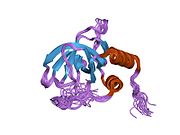PCOLCE
| PCOLCE | |||||||||||||||||||||||||||||||||||||||||||||||||||
|---|---|---|---|---|---|---|---|---|---|---|---|---|---|---|---|---|---|---|---|---|---|---|---|---|---|---|---|---|---|---|---|---|---|---|---|---|---|---|---|---|---|---|---|---|---|---|---|---|---|---|---|
 | |||||||||||||||||||||||||||||||||||||||||||||||||||
| |||||||||||||||||||||||||||||||||||||||||||||||||||
| Identifiers | |||||||||||||||||||||||||||||||||||||||||||||||||||
| Aliases | PCOLCE, PCPE, PCPE-1, PCPE1, procollagen C-endopeptidase enhancer | ||||||||||||||||||||||||||||||||||||||||||||||||||
| External IDs | OMIM: 600270; MGI: 105099; HomoloGene: 1946; GeneCards: PCOLCE; OMA:PCOLCE - orthologs | ||||||||||||||||||||||||||||||||||||||||||||||||||
| |||||||||||||||||||||||||||||||||||||||||||||||||||
| |||||||||||||||||||||||||||||||||||||||||||||||||||
| |||||||||||||||||||||||||||||||||||||||||||||||||||
| |||||||||||||||||||||||||||||||||||||||||||||||||||
| |||||||||||||||||||||||||||||||||||||||||||||||||||
| Wikidata | |||||||||||||||||||||||||||||||||||||||||||||||||||
| |||||||||||||||||||||||||||||||||||||||||||||||||||
Procollagen C-endopeptidase enhancer 1 is an enzyme that in humans is encoded by the PCOLCE gene.[5][6][7]
Fibrillar collagen types I-III are synthesized as precursor molecules known as procollagens. These precursors contain amino- and carboxyl-terminal peptide extensions known as N- and C-propeptides, respectively, which are cleaved, upon secretion of procollagen from the cell, to yield the mature triple helical, highly structured fibrils. This gene encodes a glycoprotein which binds and drives the enzymatic cleavage of type I procollagen and heightens activity.[7]
References
- ^ a b c GRCh38: Ensembl release 89: ENSG00000106333 – Ensembl, May 2017
- ^ a b c GRCm38: Ensembl release 89: ENSMUSG00000029718 – Ensembl, May 2017
- ^ "Human PubMed Reference:". National Center for Biotechnology Information, U.S. National Library of Medicine.
- ^ "Mouse PubMed Reference:". National Center for Biotechnology Information, U.S. National Library of Medicine.
- ^ Takahara K, Osborne L, Elliott RW, Tsui LC, Scherer SW, Greenspan DS (Mar 1997). "Fine mapping of the human and mouse genes for the type I procollagen COOH-terminal proteinase enhancer protein". Genomics. 31 (2): 253–256. doi:10.1006/geno.1996.0043. PMID 8824813.
- ^ Glockner G, Scherer S, Schattevoy R, Boright A, Weber J, Tsui LC, Rosenthal A (Dec 1998). "Large-scale sequencing of two regions in human chromosome 7q22: analysis of 650 kb of genomic sequence around the EPO and CUTL1 loci reveals 17 genes". Genome Res. 8 (10): 1060–1073. doi:10.1101/gr.8.10.1060. PMC 310788. PMID 9799793.
- ^ a b "Entrez Gene: PCOLCE procollagen C-endopeptidase enhancer".
Further reading
- Takahara K, Kessler E, Biniaminov L, et al. (1994). "Type I procollagen COOH-terminal proteinase enhancer protein: identification, primary structure, and chromosomal localization of the cognate human gene (PCOLCE)". J. Biol. Chem. 269 (42): 26280–26285. doi:10.1016/S0021-9258(18)47191-8. PMID 7523404.
- Scott IC, Clark TG, Takahara K, et al. (1999). "Structural organization and expression patterns of the human and mouse genes for the type I procollagen COOH-terminal proteinase enhancer protein". Genomics. 55 (2): 229–234. doi:10.1006/geno.1998.5663. PMID 9933570.
- Mott JD, Thomas CL, Rosenbach MT, et al. (2000). "Post-translational proteolytic processing of procollagen C-terminal proteinase enhancer releases a metalloproteinase inhibitor". J. Biol. Chem. 275 (2): 1384–1390. doi:10.1074/jbc.275.2.1384. PMID 10625689.
- Ricard-Blum S, Bernocco S, Font B, et al. (2002). "Interaction properties of the procollagen C-proteinase enhancer protein shed light on the mechanism of stimulation of BMP-1". J. Biol. Chem. 277 (37): 33864–33869. doi:10.1074/jbc.M205018200. PMID 12105202.
- Ligon AH, Scott IC, Takahara K, et al. (2002). "PCOLCE deletion and expression analyses in uterine leiomyomata". Cancer Genet. Cytogenet. 137 (2): 133–137. doi:10.1016/S0165-4608(02)00547-2. PMID 12393284.
- Steiglitz BM, Keene DR, Greenspan DS (2003). "PCOLCE2 encodes a functional procollagen C-proteinase enhancer (PCPE2) that is a collagen-binding protein differing in distribution of expression and post-translational modification from the previously described PCPE1". J. Biol. Chem. 277 (51): 49820–49830. doi:10.1074/jbc.M209891200. PMID 12393877.
- Strausberg RL, Feingold EA, Grouse LH, et al. (2003). "Generation and initial analysis of more than 15,000 full-length human and mouse cDNA sequences". Proc. Natl. Acad. Sci. U.S.A. 99 (26): 16899–16903. Bibcode:2002PNAS...9916899M. doi:10.1073/pnas.242603899. PMC 139241. PMID 12477932.
- Bernocco S, Steiglitz BM, Svergun DI, et al. (2003). "Low resolution structure determination shows procollagen C-proteinase enhancer to be an elongated multidomain glycoprotein". J. Biol. Chem. 278 (9): 7199–7205. doi:10.1074/jbc.M210857200. PMID 12486138.
- Liepinsh E, Banyai L, Pintacuda G, et al. (2003). "NMR structure of the netrin-like domain (NTR) of human type I procollagen C-proteinase enhancer defines structural consensus of NTR domains and assesses potential proteinase inhibitory activity and ligand binding". J. Biol. Chem. 278 (28): 25982–25989. doi:10.1074/jbc.M302734200. PMID 12670942.
- Gerhard DS, Wagner L, Feingold EA, et al. (2004). "The status, quality, and expansion of the NIH full-length cDNA project: the Mammalian Gene Collection (MGC)". Genome Res. 14 (10B): 2121–2127. doi:10.1101/gr.2596504. PMC 528928. PMID 15489334.
- Petropoulou V, Garrigue-Antar L, Kadler KE (2005). "Identification of the minimal domain structure of bone morphogenetic protein-1 (BMP-1) for chordinase activity: chordinase activity is not enhanced by procollagen C-proteinase enhancer-1 (PCPE-1)". J. Biol. Chem. 280 (24): 22616–22623. doi:10.1074/jbc.M413468200. PMID 15817489.
- Ge G, Zhang Y, Steiglitz BM, Greenspan DS (2006). "Mammalian tolloid-like 1 binds procollagen C-proteinase enhancer protein 1 and differs from bone morphogenetic protein 1 in the functional roles of homologous protein domains". J. Biol. Chem. 281 (16): 10786–10798. doi:10.1074/jbc.M511111200. PMID 16507574.
- Blanc G, Font B, Eichenberger D, et al. (2007). "Insights into how CUB domains can exert specific functions while sharing a common fold: conserved and specific features of the CUB1 domain contribute to the molecular basis of procollagen C-proteinase enhancer-1 activity" (PDF). J. Biol. Chem. 282 (23): 16924–16933. doi:10.1074/jbc.M701610200. PMID 17446170. Archived from the original on 2018-07-23.
- v
- t
- e
-
 1uap: NMR structure of the NTR domain from human PCOLCE1
1uap: NMR structure of the NTR domain from human PCOLCE1
 | This article on a gene on human chromosome 7 is a stub. You can help Wikipedia by expanding it. |
- v
- t
- e

















